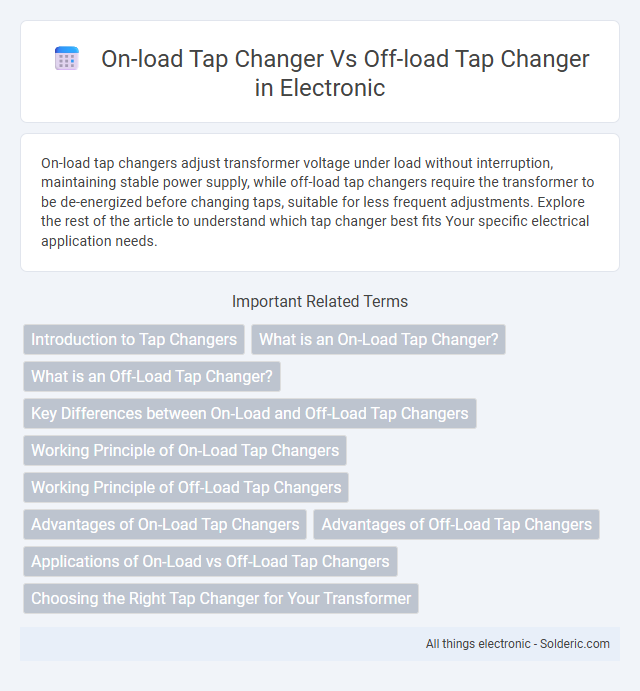On-load tap changers adjust transformer voltage under load without interruption, maintaining stable power supply, while off-load tap changers require the transformer to be de-energized before changing taps, suitable for less frequent adjustments. Explore the rest of the article to understand which tap changer best fits Your specific electrical application needs.
Comparison Table
| Feature | On-Load Tap Changer (OLTC) | Off-Load Tap Changer (OLTC) |
|---|---|---|
| Operation | Changes taps without interrupting load current | Requires transformer to be de-energized before changing taps |
| Usage | Voltage regulation under load conditions | Voltage adjustment only during no-load or shutdown |
| Complexity | More complex and costly due to switching components | Simple design, lower cost and maintenance |
| Switching Speed | Fast, seamless tap changes | Slow, manual or motor-operated tap changes |
| Applications | Power transformers in transmission & distribution networks | Distribution transformers and applications with infrequent tap changes |
| Maintenance | Requires regular maintenance due to moving contacts | Minimal maintenance needed |
| Cost | Higher initial and operational cost | Lower cost |
Introduction to Tap Changers
Tap changers are essential components in transformers that regulate voltage levels by adjusting transformer winding taps without interrupting power flow in on-load tap changers (OLTC) or requiring power shutdown in off-load tap changers (OLTC). On-load tap changers allow seamless voltage regulation under load conditions, enhancing system stability and reducing downtime, whereas off-load tap changers necessitate transformer de-energization for tap adjustments. Your choice between these two depends on the operational requirements of voltage control, system reliability, and maintenance flexibility.
What is an On-Load Tap Changer?
An On-Load Tap Changer (OLTC) is a device integrated into transformers that adjusts the transformer winding taps while the transformer remains energized and under load, ensuring continuous voltage regulation without interrupting power supply. It uses motor-driven mechanisms and diverter switches to smoothly transition between tap positions, preventing voltage fluctuations and maintaining stable output voltage. OLTCs are critical in applications requiring precise voltage control, such as power distribution networks and renewable energy systems, where load conditions vary frequently.
What is an Off-Load Tap Changer?
An Off-Load Tap Changer (OLTC) adjusts transformer voltage by changing taps only when the transformer is de-energized, ensuring no load interruption during tap transitions. It is commonly used in applications where voltage regulation is needed during maintenance or when load switching can be scheduled without affecting operations. OLTCs are simpler and less expensive than On-Load Tap Changers but cannot regulate voltage continuously under load conditions.
Key Differences between On-Load and Off-Load Tap Changers
On-load tap changers (OLTC) adjust transformer voltage under load conditions without interrupting power flow, ensuring continuous voltage regulation and stability. Off-load tap changers (OLTC) require the transformer to be de-energized before changing taps, making them suitable for infrequent adjustments and maintenance. The primary difference lies in operational flexibility, with on-load tap changers enabling real-time voltage control and off-load tap changers necessitating power shutdown during tap changes.
Working Principle of On-Load Tap Changers
On-load tap changers (OLTC) adjust transformer winding taps in real-time without interrupting the power supply, utilizing diverter and selector switches to transfer load current between taps smoothly. These switches operate in coordination to temporarily bypass and shift the load current through different taps, enabling voltage regulation under full load conditions. This mechanism contrasts with off-load tap changers, which require de-energizing the transformer before tap adjustments are made, limiting their use to no-load conditions.
Working Principle of Off-Load Tap Changers
Off-load tap changers operate by interrupting the transformer load before adjusting taps, ensuring isolation during the switching process to prevent current flow. This method uses manual or motorized mechanisms to shift the transformer winding taps only when the transformer is de-energized or disconnected from the load. Unlike on-load tap changers that adjust voltage under load, off-load tap changers provide simple, cost-effective voltage regulation but require transformer downtime for operation.
Advantages of On-Load Tap Changers
On-load tap changers offer continuous voltage regulation without interrupting power supply, ensuring stable and reliable transformer operation. They enhance system efficiency by allowing voltage adjustments under full load, reducing downtime and maintenance costs compared to off-load tap changers. Your power system benefits from improved flexibility and minimized operational disruptions through the seamless voltage control provided by on-load tap changers.
Advantages of Off-Load Tap Changers
Off-load tap changers offer the advantage of simpler design and lower maintenance costs due to their operation only when the transformer is de-energized. This type reduces the risk of arcing and wear, enhancing transformer longevity and reliability. Your equipment benefits from increased safety and easier servicing since tap changes are performed without load current.
Applications of On-Load vs Off-Load Tap Changers
On-load tap changers (OLTC) are essential for regulating voltage in power transformers without interrupting the current, making them ideal for applications requiring continuous voltage adjustment under load, such as utility substations and industrial power systems. Off-load tap changers (DETC) are suitable for maintenance or settings adjustments performed only when the transformer is de-energized, commonly used in distribution transformers where load variations are minimal. Your choice depends on whether uninterrupted voltage control or simpler, less frequent adjustments are needed for reliable transformer operation.
Choosing the Right Tap Changer for Your Transformer
Selecting the appropriate tap changer for your transformer depends on operational requirements and load conditions. On-load tap changers (OLTC) allow voltage regulation without interrupting power supply, making them ideal for applications requiring continuous voltage adjustment during load. Off-load tap changers (OLTC) must be operated with the transformer de-energized, suitable for systems with stable voltage and less frequent adjustments.
on-load tap changer vs off-load tap changer Infographic

 solderic.com
solderic.com